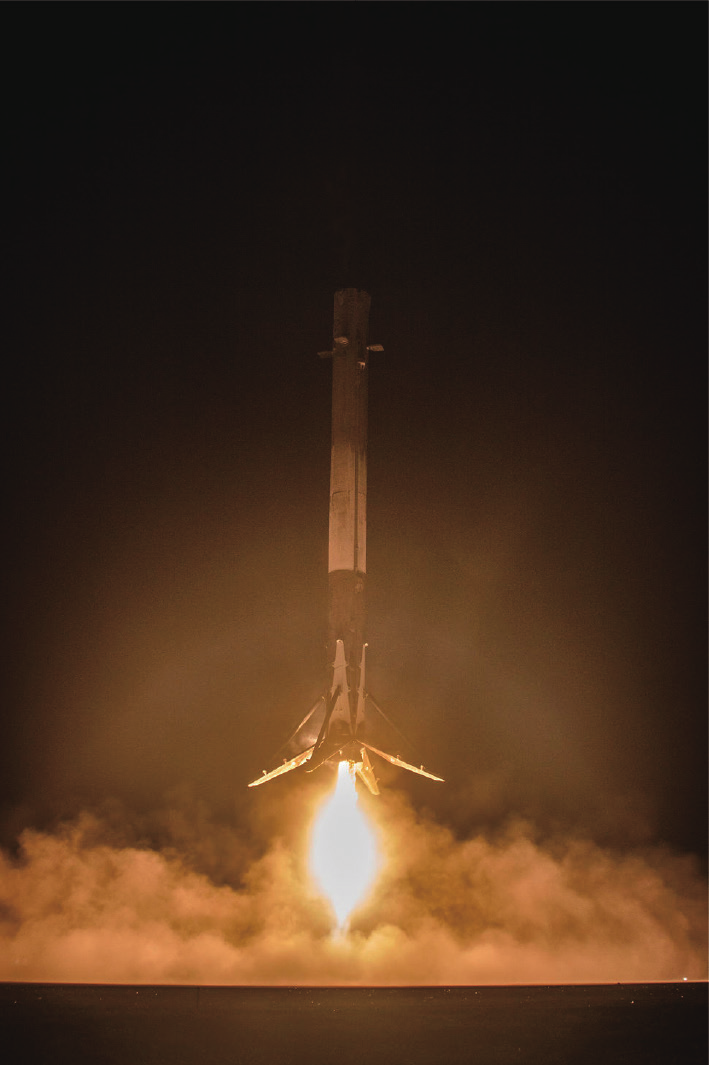On April 8, 2016, a SpaceX Falcon 9 rocket launched a payload from Cape Canaveral Air Force Station in Florida USA and the first stage rocket returned to earth onto a floating drone ship in the Atlantic Ocean [1]. This was only the second time an orbital class rocket achieved a successful touchdown. The first time was December 21, 2015, when a Falcon 9 was launched from Cape Canaveral and returned to the launching pad [2] (Fig. 1). In the past, first stage rockets were designed to burn up on reentry. These recovery operations represent impressive achievements in guidance, navigation, and control, and provided some spectacular long range video [1-3] and still pictures of the barge landing from the perspective of the barge [4].
A landing on an ocean platform requires less fuel to maneuver the rocket into position to land. If the required rocket trajectory is too far down range or a heavy payload requires use of too much of the available fuel, it would be impractical to direct the rocket's path back to the launch pad. A drone ship can be placed at or near the area where the rocket would most naturally touchdown downrange. Only about one-third of SpaceX launches are expected to be able to return to the pad. The tradeoff is whether the rocket can be immediately on the pad to be prepared for reuse. The video in Ref. [1] provides informative schematic drawings of the different flight path schemes.
《Fig. 1》

Fig.1 The first stage rocket is shown just prior to touchdown on the launch pad, with support legs deployed at the bottom and grid fins deployed at the top to manipulate direction of lift during reentry.
SpaceX is a private company, founded in 2002, to design, manufacture, and launch advanced rockets and spacecraft. Its primary vehicle is the Falcon 9 rocket which is powered by nine Merlin engines with a combined thrust of about 6806 kN (1.53 × 106 lbf) at sea level [5]. The Merlin 1D rocket engine, full thrust version, has a thrust to weight ratio of 180.1, almost twice that of the Saturn V first stage rocket F-1 engine (94.1) [6]. It is powered by liquid oxygen and rocket-grade kerosene. SpaceX has asserted that the Falcon 9 can suffer failure of two of its nine engines and still complete its mission. The rocket can deliver 13 150 kg (28 991 lb) to Low Earth Orbit (LEO). Prior to the recent efforts to demonstrate rocket re-landing, Falcon 9 has been used in multiple successful missions, including to resupply the International Space Station (including the first barge recovery) and to launch various satellites (the first recovery occurred as part of a mission to deploy eleven communications satellites for a customer: Orbcomm). It is planned to use it for manned missions, within a few years, in combination with a pressurized crew capsule named Dragon. SpaceX, though a young company and engaged in technically complex activities, which were previously primarily the domain of national governments, is reported to be profitable and has a positive cash flow [7].
The Falcon 9 flights are part of the SpaceX strategy to use reusable rockets to reduce launch costs to establish and sustain a cost effective commercial launch business. Design for reuse means, among other things, not allowing the rocket to burn up on reentry and providing retractable legs that deploy when the rocket touches down. There is a cost tradeoff in additional fuel needed for landing, but fuel costs are nominal (a full rocket requires $200 000 USD of fuel) compared to the $16 million USD cost of the Falcon 9 aluminum-lithium alloy rocket body and fuel tanks and associated hardware. SpaceX presently quotes a price of about $61 million USD for a Falcon 9 launch and President Gwynne Shotwell said launch costs will decrease by about 30% because of reusable rockets.
The Falcon Heavy is currently under development and is based on a Falcon 9 configured with two additional engine cores for the first stage, each containing the same cluster of nine Merlin engines as the Falcon 9. The Falcon Heavy, projected for its first launch in 2016, is expected to be the most powerful rocket available on the international rocket scene with a payload capability of 53 000 kg to LEO, twice that of the next most capable vehicle, the Delta IV Heavy, and with an expected launch cost of about $90 million USD, about one-third the cost for the Delta [8].













 京公网安备 11010502051620号
京公网安备 11010502051620号




